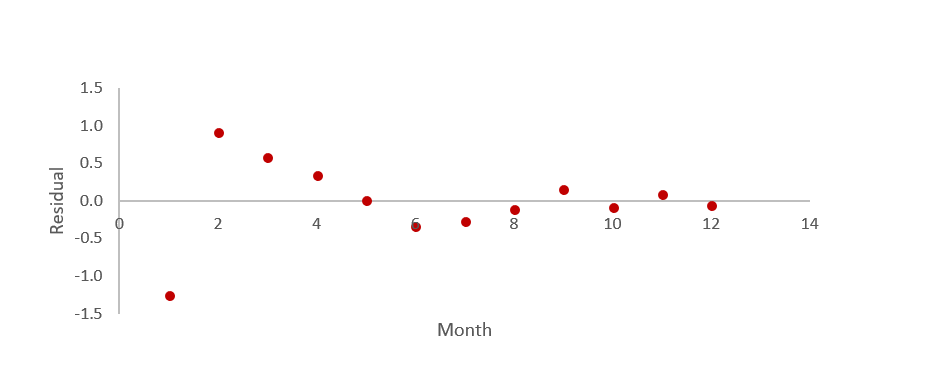

Residuals in a statistical or machine learning model are the differences between observed and predicted values of data. They are a diagnostic measure used when assessing the quality of a model. They are also known as errors.
Example of residuals
The middle column of the table below, Inflation, shows US inflation data for each month in 2017. The Predicted column shows predictions from a model attempting to predict the inflation rate. The residuals are shown in the Residual column and are computed as Residual = Inflation - Predicted. In the case of the data for January 2017, the observed inflation was 0.5%, the model has predicted 1.8%, so the residual is -1.3%.

The chart below shows the data in the table. You can read the residuals as being the difference between the observed values of inflation (the dots) and the predicted values (the dotted line).

Why are residuals important?
Residuals are important when determining the quality of a model. You can examine residuals in terms of their magnitude and/or whether they form a pattern.
Where the residuals are all 0, the model predicts perfectly. The further residuals are from 0, the less accurate the model. In the case of linear regression, the greater the sum of squared residuals, the smaller the R-squared statistic, all else being equal.
Where the average residual is not 0, it implies that the model is systematically biased (i.e., consistently over- or under-predicting).
Where residuals contain patterns, it implies that the model is qualitatively wrong, as it is failing to explain some property of the data. The existence of patterns invalidates most statistical tests.
Diagnosing problems by looking for patterns in residuals
If some of the residuals are relatively large compared to others, either the data or model may be flawed. The next step is to investigate and work out what has specifically led to the unusually large residual.
In the example above, the residuals for January and February are much further from 0 than the residuals for the other months. Thus, it may be worthwhile to investigate what was unusual about January. Unusually large residuals are called outliers or extreme values.

Another common type of pattern in residuals is when we can predict the value of residuals based on the preceding values of residuals. This is known variously as autocorrelation, serial correlation, and serial dependence. The residuals in this case to seem to have a snake-like pattern - evidence of autocorrelation.
Another type of pattern is where the degree of variation in the residuals seems to change over time. This pattern is known as heteroscedasticity. In the plot above, we can see some evidence of heteroscedasticity, with residuals in months 1 through 4 being further from 0 than the residuals from months 5 through 12.
Another type of pattern relates to the distribution of the residuals. In some situations, it can be informative to see if the residuals are distributed in accordance with the normal distribution.
Different types of residuals
Sometimes residuals are scaled (i.e., divided by a number) to make them easier to interpret. In particular, standardized and studentized residuals typically rescale the residuals so that values of more than 1.96 from 0 equate to a p-value of 0.05. Different software packages use terminology inconsistently. Also, most packages do not adjust for multiple comparison correction errors, so be careful when reading documentation using scaled residuals.
Head on over to the Displayr blog to find out more about all things data science and machine learning.





